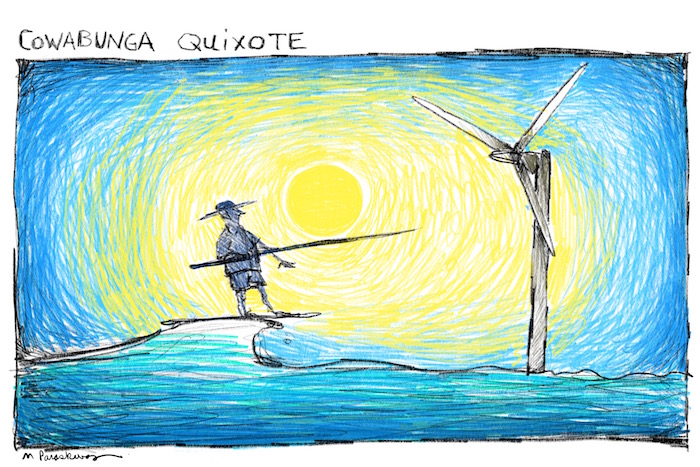Power to the People: Windmill Farm off Montauk Will Be Second in the Country

Two weeks ago, the Long Island Power Authority (LIPA) signed a contract with a company called Deepwater Wind to construct 15 windmills in the sea 35 miles offshore of Montauk to provide wind power to the Hamptons. Three or four years from now, these windmills (or turbines, as they are also called) will create electricity, bring it ashore by underwater cable at a landing point in Napeague and then underground to the East Hampton power station on Race Lane. The power thus created by the offshore wind will be enough to light and power an estimated 50,000 homes—which at the present time is just about the total number of homes here.
When the electricity arrives, LIPA will buy it from Deepwater Wind at the same prices they now pay to solar panel and other environmentally friendly power producers. The net result, expected to begin in 2020, will be power at costs not much different from what we pay now from those sources.
Deepwater Wind, last December, threw a switch that started windmills turning at the first ocean wind farm in America. It was a smaller project. Only five windmills. And it was visible from land, 3.3 miles southeast off Block Island, the little island off Montauk. That windmill project will enable Block Islanders to shut down the diesel power plant on the island and, with their smaller population, use the electricity from the wind to power the island. The electricity left over goes by underwater cable to a beach in Narragansett, Rhode Island, to provide electricity to a good part of Rhode Island.
Wind power from windmills is now being proposed for the ocean off Long Island and New England by half a dozen companies, some American, like Deepwater Wind, and some foreign—for example Dong Energy from Denmark, StatOil from Norway, and Iberdrola from Spain. The interest in our particular patch of ocean is that the waters are shallow and the winds are strong. Deepwater Wind leases sites from the federal government and must get the sign-off of the Bureau of Ocean Energy Management. Other companies do, too. StatOil has just won a bidding war to lease 79,000 acres of ocean off Jones Beach. Deepwater Wind currently leases enough of the ocean south of Montauk to build 200 turbines. That could power 2 million homes, just by Deepwater Wind alone.
If you think this is an answer to our prayers when it comes to global warming, you are probably right. But wait a minute.
We will have to contend with President Trump. We all know that, before he became President, he threatened to pull his golf course development out of Scotland if the offshore windmills planned for construction were within sight of his golfers. He went to court, fought it tooth and nail all the way up to the UK Supreme Court where, finally, he still lost.
Fact is these wind projects are privately owned, and the Federal Bureau of Ocean Energy Management still has to give its final approval. America owns the waters that extend all those miles offshore, it claims. And this isn’t going to help any coal miners or well drillers in Trump’s America.
It will help the steel industry, however. These windmills are made of steel. American steel? Maybe, maybe not. The Rhode Island windmills, are already ordered and in place, are Alstom Group Hallade 1506 MW machines. Alstom is a French company. However, the energy division was sold three years ago to GE, the AMERICAN company with its headquarters in Boston. SO IT’S OKAY!
And now, of course, I know the BIG question on all your minds. It’s the same question that was bugging Trump in Scotland. Can the folks sitting in deck chairs on a dune in Montauk see these contraptions marring the horizon out in the Atlantic?
Well, it’s a clear shot and it comes down to the curvature of the earth and what’s what far away. There’s an actual mathematical formula that can be used for this. A friend of mine told me he Googled it, printed it out and then did the math.
He explains, “If the windmills are the same as the ones off Block Island, then they will be nearly 600 feet tall. They will stand on steel platforms rising above the ocean to be clear of the sea. If you add the dune and the platform and sit in a deck chair, you probably will not see them. Reports in The New York Times and Wall Street Journal have said you will not be able to see them from land in Montauk. But, he asked me, what if you stand up and are six feet off the ground (could have to be on tiptoe), is there a chance you might actually see the tops of the tips of these windmills?
Of course, there are other considerations. At 35 miles off, most of the time, the general atmospheric mist over the ocean will blot out your view of this horizon. Fog will do it, rain will do it, too much carbon dioxide or jet fuel hovering low will do it. On the other hand, my friend asks, if there is a particular kind of cloud inversion at the horizon and it is a clear, sparkling, bright sunny day, who knows?”
Here is the link to this website that can allow you to make this calculation for yourself: ringbell.co.uk/info/hdist.htm.
There is something else to consider he says. It’s the propeller blades. If one of the three blades comes to a halt sticking straight up when the wind dies, you’ll need to add that to the total height. On the other hand, these propellers are very skinny. Is it really possible to see something that thin sticking up 35 miles off?
Well, let’s move on. What do these windmills out in the ocean mean for the fish? Or for the birds? Or the endangered fish or birds? Or for the fishing boat captains who might have had too much to drink and it’s foggy anyway? Potential Perils abound. No doubt about it.
And what about, when the cables come up on the beach and you step on one? You get electrocuted? No. They thought of that and will cover them up.
Finally, there is the fact that this is maybe too little too late, this little patch of windmills in the ocean off Montauk. Gas, oil and coal continue to be burned worldwide in staggering amounts. The seas are rising. I just read that a piece of the Larsen Glacier is starting to separate itself from Antarctica. When it floats off and melts—this could happen tomorrow—just that alone will raise the sea level around the world in one pop, sure as shootin,’ the same way the liquid in a glass rises up when you plop an ice cube into it. What happens when the seas rise 10 feet? Will the seas swallow the windmills? Will those remaining now be LESS visible from shore because sea level is higher? Finally, there is the matter of the more than two dozen wood-shingled early 19th century windmills that have been preserved and now sit heroically on hills and in public greens all around the Hamptons, the North Fork, Block Island, Cape Cod, Nantucket and Martha’s Vineyard.
When we put white canvas sails on all their blades in the summertime and these propellers on these ocean windmills begin pushing a brisk wind toward shore would the blades of our windmills respond to their high-tech cousins at sea in a harmonious way, making even MORE wind power?
Now wouldn’t that be something?



